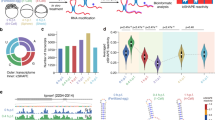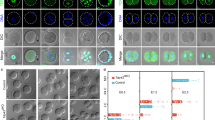Abstract
A fundamental process occurring during early development is the zygotic genome activation, i.e., the initiation of transcription from the embryonic genome. Before that step, cellular processes in the developing embryo are dictated by transcripts produced by the maternal genome and accumulated in the egg during oogenesis. The maternal-to-zygotic transition (MZT) involves both the clearance of maternal RNAs and the initiation of transcription of the embryonic genome and is a tightly regulated process. In some species, decay of maternal transcripts may be facilitated by the activity of microRNAs. These small RNAs can act pleiotropically, blocking translation and inducing destabilization of hundreds of different maternal targets. In this review, we will discuss the role of microRNAs during MZT, focusing on Drosophila melanogaster and vertebrate models, Xenopus laevis, Zebrafish and mouse, in which such a mechanism has been more extensively studied.
Access this chapter
Tax calculation will be finalised at checkout
Purchases are for personal use only
Similar content being viewed by others
References
Rosa A, Brivanlou AH (2009) microRNAs in early vertebrate development. Cell Cycle 8:3513–3520
Lee Y, Kim M, Han J et al (2004) MicroRNA genes are transcribed by RNA polymerase II. EMBO J 23(20):4051–4060
Lee Y, Ahn C, Han J et al (2003) The nuclear RNase III Drosha initiates microRNA processing. Nature 425(6956):415–419
Denli AM, Tops BB, Plasterk RH et al (2004) Processing of primary microRNAs by the Microprocessor complex. Nature 432(7014):231–235
Gregory RI, Yan KP, Amuthan G et al (2004) The Microprocessor complex mediates the genesis of microRNAs. Nature 432(7014):235–240
Han J, Lee Y, Yeom KH et al (2004) The Drosha-DGCR8 complex in primary microRNA processing. Genes Dev 18(24):3016–3027
Morlando M, Dini Modigliani S, Torrelli G et al (2012) FUS stimulates microRNA biogenesis by facilitating co-transcriptional Drosha recruitment. EMBO J 31:4502–4510
Lee Y, Jeon K, Lee JT et al (2002) MicroRNA maturation: stepwise processing and subcellular localization. EMBO J 21(17):4663–4670
Landgraf P, Rusu M, Sheridan R et al (2007) A mammalian microRNA expression atlas based on small RNA library sequencing. Cell 129:1401–1414
Johanson TM, Lew AM, Chong MM (2013) MicroRNA-independent roles of the RNase III enzymes Drosha and Dicer. Open Biol 3(10):130144. doi:10.1098/rsob.130144
Ruby JG, Jan CH, Bartel DP (2007) Intronic microRNA precursors that bypass Drosha processing. Nature 448(7149):83–86
Grishok A, Pasquinelli AE, Conte D et al (2001) Genes and mechanisms related to RNA interference regulate expression of the small temporal RNAs that control C. elegans developmental timing. Cell 106(1):23–34
Hutvágner G, Zamore PD (2002) A microRNA in a multiple-turnover RNAi enzyme complex. Science 297(5589):2056–2060
Meister G (2013) Argonaute proteins: functional insights and emerging roles. Nat Rev Genet 14(7):447–459. doi:10.1038/nrg3462
Bartel DP (2009) MicroRNAs: target recognition and regulatory functions. Cell 136(2):215–233. doi:10.1016/j.cell.2009.01.002
Jonas S, Izaurralde E (2015) Towards a molecular understanding of microRNA-mediated gene silencing. Nat Rev Genet 16(7):421–433. doi:10.1038/nrg3965
Vasudevan S, Tong Y, Steitz JA (2007) Switching from repression to activation: microRNAs can up-regulate translation. Science 318(5858):1931–1934
Brennecke J, Stark A, Russell RB et al (2005) Principles of microRNA-target recognition. PLoS Biol 3:e85
Lewis BP, Burge CB, Bartel DP (2005) Conserved seed pairing, often flanked by adenosines, indicates that thousands of human genes are microRNA targets. Cell 120:15–20
Rajewsky N (2006) microRNA target predictions in animals. Nat Genet 38:S8–13
Laver JD, Marsolais AJ, Smibert CA et al (2015) Regulation and function of maternal gene products during the maternal-to-zygotic transition in Drosophila. Curr Top Dev Biol 113:43–84. doi:10.1016/bs.ctdb.2015.06.007
Svoboda P, Franke V, Schultz RM (2015) Sculpting the transcriptome during the oocyte-to-embryo transition in mouse. Curr Top Dev Biol 113:305–349
Yartseva V, Giraldez AJ (2015) The maternal-to-zygotic transition during vertebrate development: a model for reprogramming. Curr Top Dev Biol 113:191–232
Lee RC, Feinbaum RL, Ambros V (1993) The C. elegans heterochronic gene lin-4 encodes small RNAs with antisense complementarity to lin-14. Cell 75:843–854
Reinhart BJ, Slack FJ, Basson M et al (2000) The 21-nucleotide let-7 RNA regulates developmental timing in Caenorhabditis elegans. Nature 403:901–906
Pasquinelli AE, Reinhart BJ, Slack F et al (2000) Conservation of the sequence and temporal expression of let-7 heterochronic regulatory RNA. Nature 408:86–89
Bushati N, Stark A, Brennecke J et al (2008) Temporal reciprocity of miRNAs and their targets during the maternal-to-zygotic transition in Drosophila. Curr Biol 18:501–506
Liang HL, Nien CY, Liu HY et al (2008) The zinc-finger protein Zelda is a key activator of the early zygotic genome in Drosophila. Nature 456(7220):400–403. doi:10.1038/nature07388
Fu S, Nien CY, Liang HL et al (2014) Co-activation of microRNAs by Zelda is essential for early Drosophila development. Development 141(10):2108–2118. doi:10.1242/dev.108118
Benoit B, He CH, Zhang F et al (2009) An essential role for the RNA-binding protein Smaug during the Drosophila maternal-to-zygotic transition. Development 136(6):923–932
Wienholds E, Kloosterman WP, Miska E et al (2005) MicroRNA expression in zebrafish embryonic development. Science 309:310–311
Giraldez AJ, Cinalli RM, Glasner ME et al (2005) MicroRNAs regulate brain morphogenesis in zebrafish. Science 308:833–838
Wienholds E, Koudijs MJ, van Eeden FJM et al (2003) The microRNA-producing enzyme Dicer1 is essential for zebrafish development. Nat Genet 35:217–218
Choi W-Y, Giraldez AJ, Schier AF (2007) Target protectors reveal dampening and balancing of Nodal agonist and antagonist by miR-430. Science 318:271–274
Giraldez AJ (2006) Zebrafish MiR-430 promotes deadenylation and clearance of maternal mRNAs. Science 312:75–79
Pillai RS, Bhattacharyya SN, Artus CG et al (2005) Inhibition of translational initiation by Let-7 MicroRNA in human cells. Science 309:1573–1576
Bazzini AA, Lee MT, Giraldez AJ (2012) Ribosome profiling shows that miR-430 reduces translation before causing mRNA decay in zebrafish. Science 336:233–237. doi:10.1126/science.1215704
Lee MT, Bonneau AR, Takacs CM et al (2013) Nanog, Pou5f1 and SoxB1 activate zygotic gene expression during the maternal-to-zygotic transition. Nature 503:360–364. doi:10.1038/nature12632
Boyer LA, Lee TI, Cole MF et al (2005) Core transcriptional regulatory circuitry in human embryonic stem cells. Cell 122:947–956
Marson A, Levine SS, Cole MF et al (2008) Connecting microRNA genes to the core transcriptional regulatory circuitry of embryonic stem cells. Cell 134:521–533
Rosa A, Brivanlou AH (2011) A regulatory circuitry comprised of miR-302 and the transcription factors OCT4 and NR2F2 regulates human embryonic stem cell differentiation. EMBO J 30:237–248
Watanabe T, Takeda A, Mise K et al (2005) Stage-specific expression of microRNAs during Xenopus development. FEBS Lett 579:318–324
Rosa A, Spagnoli FM, Brivanlou AH (2009) The miR-430/427/302 family controls mesendodermal fate specification via species-specific target selection. Dev Cell 16:517–527
Lund E, Liu M, Hartley RS et al (2009) Deadenylation of maternal mRNAs mediated by miR-427 in Xenopus laevis embryos. RNA 15:2351–2363. doi:10.1261/rna.1882009
Lund E, Sheets MD, Imboden SB et al (2011) Limiting Ago protein restricts RNAi and microRNA biogenesis during early development in Xenopus laevis. Genes Dev 25:1121–1131. doi:10.1101/gad.2038811
Audic Y, Anderson C, Bhatty R et al (2001) Zygotic regulation of maternal cyclin A1 and B2 mRNAs. Mol Cell Biol 21:1662–1671
Audic Y, Garbrecht M, Fritz B et al (2002) Zygotic control of maternal cyclin A1 translation and mRNA stability. Dev Dyn 225:511–521
Yamaguchi T, Kataoka K, Watanabe K et al (2014) Restriction of the Xenopus DEADSouth mRNA to the primordial germ cells is ensured by multiple mechanisms. Mech Dev 131:15–23. doi:10.1016/j.mod.2013.11.002
Tang F, Kaneda M, O’Carroll D et al (2007) Maternal microRNAs are essential for mouse zygotic development. Genes Dev 21:644–648
Ohnishi Y, Totoki Y, Toyoda A et al (2010) Small RNA class transition from siRNA/piRNA to miRNA during pre-implantation mouse development. Nucleic Acids Res 38:5141–5151
Ma J, Flemr M, Stein P et al (2010) MicroRNA activity is suppressed in mouse oocytes. Curr Biol 20:265–270
Suh N, Baehner L, Moltzahn F et al (2010) MicroRNA function is globally suppressed in mouse oocytes and early embryos. Curr Biol 20:271–277
Murchison EP, Stein P, Xuan Z et al (2007) Critical roles for Dicer in the female germline. Genes Dev 21:682–693
Lykke-Andersen K, Gilchrist MJ, Grabarek JB et al (2008) Maternal Argonaute 2 is essential for early mouse development at the maternal-zygotic transition. Mol Biol Cell 19:4383–4392. doi:10.1091/mbc.E08-02-0219
Svoboda P, Flemr M (2010) The role of miRNAs and endogenous siRNAs in maternal-to-zygotic reprogramming and the establishment of pluripotency. EMBO Rep 11:590–597
Giraldez AJ (2010) microRNAs, the cell’s Nepenthe: clearing the past during the maternal-to-zygotic transition and cellular reprogramming. Curr Opin Genet Dev 20:369–375
Grimson A, Farh KK-H, Johnston WK et al (2007) MicroRNA targeting specificity in mammals: determinants beyond seed pairing. Mol Cell 27:91–105
Acknowledgments
We thank Tomomi Haremaki for providing images of X. laevis and zebrafish development. This work has been supported by funding from Sapienza University to A.R. and Rockefeller University to A.H.B.
Author information
Authors and Affiliations
Corresponding author
Editor information
Editors and Affiliations
Rights and permissions
Copyright information
© 2017 Springer Science+Business Media LLC
About this protocol
Cite this protocol
Rosa, A., Brivanlou, A.H. (2017). Role of MicroRNAs in Zygotic Genome Activation: Modulation of mRNA During Embryogenesis. In: Lee, K. (eds) Zygotic Genome Activation. Methods in Molecular Biology, vol 1605. Humana Press, New York, NY. https://doi.org/10.1007/978-1-4939-6988-3_3
Download citation
DOI: https://doi.org/10.1007/978-1-4939-6988-3_3
Published:
Publisher Name: Humana Press, New York, NY
Print ISBN: 978-1-4939-6986-9
Online ISBN: 978-1-4939-6988-3
eBook Packages: Springer Protocols




